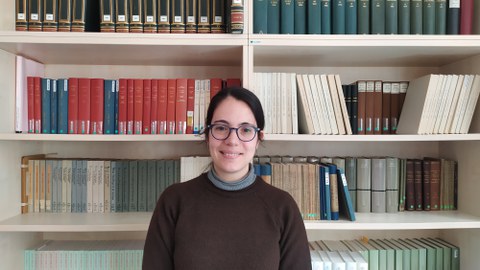Nov 06, 2024
Interview with Clara Renedo Mirambell
Clara Renedo Mirambell is a postdoctoral fellow in Medieval Latin, specializing in hagiography and manuscript studies. Her most recent project concerns the study of a corpus of hagiographic and liturgical manuscripts from the Cathedral of Barcelona, which she has conducted thanks to a Margarita Salas Fellowship at Universitat Autònoma de Barcelona. In October 2024, she visited FOVOG for a one-month research stay. The interview was conducted by Rebecca Hoppe.
What are your main research interests?
My main field of research is Medieval Latin hagiography. This has been my focus since my PhD, as well as during my postdoctoral fellowship at the Universitat Autònoma de Barcelona. I am very grateful for the opportunity to be a visiting fellow at FOVOG, which is such a prestigious and unique research center. During my stay, I’m trying to develop a more precise perspective in hagiography and its narrow connections with monastic institutions, and to contribute to fostering the partnership between Saxony and Catalonia, which has also recently been strengthened with Professor Matthias M. Tischler (UAB / ICREA) becoming an associated scientist at FOVOG.
What is your particular area of interest when it comes to hagiography?
My primary interests are twofold: first, how and why hagiographic texts came to be; and secondly, how they circulated, were received and transmitted within monastic and ecclesiastic institutions. Hagiographic texts always have a purpose, whether it is to highlight a particular saint or to document a new cult. Currently, one of my focuses is the Carolingian period, as a part of which I am currently developing a perspective on translationes (the translations or movements of relics).
Which relics are you the most interested in?
That is such a difficult question! Recently I have been working on the Carolingian translatio of the relics of Vincent of Saragossa from Valencia to Castres. It is quite a fascinating story: Vincent was martyred and buried in Valencia in late Antiquity. During the 9th century, Valencia was under Muslim influence, and many Carolingian monasteries saw this as an opportunity to acquire his relics. One of them was the abbey of Saint-Germain-des-Prés, in Paris, which was consecrated to Saint Vincent, but its delegation arrived too late: shortly before, a monk of the abbey of Conques, Audaldus, had already taken the relics. However, on his way back Audaldus was retained by the bishop of Saragossa, who confiscated the relics. When he arrived to Conques empty-handed, Audaldus was not believed and was expelled from the community. He was later welcomed in the monastery of Castres. Some years later, a Catalan nobleman organized an expedition to bring the relics to Castres. He mediated with the Muslim authorities by making them believe that the remains were of a relative of his, and he was successful. Shortly after, Aimoin, a monk of Saint-Germain-des-Prés, wrote the account of the translatio.
How did you get into this subject?
It was actually by chance. As a graduate student, I specialized in Medieval Latin, with a particular interest in manuscript studies and material sources. At the end of my Master’s degree in Paris, Professor Christiane Veyrard-Cosme – who later became one of my PhD supervisors – gave me the opportunity to work on the study and the edition of a specific Carolingian manuscript, which was a compilation of hagiographic texts. This was a completely new subject for me, but once I approached it, I found it captivating. I was interested in not only the texts, but also in why and how they were assembled together (as hagiographic works, often short, tend to circulate in collections). What also intrigued me, from the philological perspective, is how these texts were frequently adapted to fit different purposes. Hagiographic texts, often anonymous and lacking the authority of Canonical sources, are particularly prone to being rewritten: for example, sometimes they might be shortened so as to better suit the liturgical practices, or in other cases they can be lengthened to add new details about the saint or its cult, or to better deliver a specific message. By studying this textual mobility, we are often able improve our understanding of how hagiographic texts were used in monastic and ecclesiastic institutions.
Do you plan to continue your research on hagiography in the future?
I definitely plan to continue exploring this topic further. However, in the last years I have also had the opportunity to work in other related areas. For example, I have been a member of the international project “Carolingian Culture in Septimania and Catalonia” (2020–2024), funded by the Austrian Academy of Sciences and led by Professors Matthias M. Tischler and Walter Pohl. As part of the project, I have been studying a corpus of Carolingian manuscripts from the Lyons’ area and down to Southern Gaul and Catalonia, in order to better understand how manuscripts and texts circulated from the center of the Empire to such peripheral regions as Catalonia and Septimania. I can imagine continuing working in this direction in the future as well.
